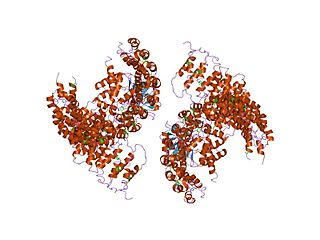
The catalytic subunit α of protein kinase A is a key regulatory enzyme that in humans is encoded by the PRKACA gene. This enzyme is responsible for phosphorylating other proteins and substrates, changing their activity. Protein kinase A catalytic subunit is a member of the AGC kinase family, and contributes to the control of cellular processes that include glucose metabolism, cell division, and contextual memory. PKA Cα is part of a larger protein complex that is responsible for controlling when and where proteins are phosphorylated. Defective regulation of PKA holoenzyme activity has been linked to the progression of cardiovascular disease, certain endocrine disorders and cancers.

Serine/threonine-protein phosphatase 2A catalytic subunit alpha isoform is an enzyme that is encoded by the PPP2CA gene.

Serine/threonine-protein phosphatase 2A 65 kDa regulatory subunit A alpha isoform is an enzyme that in humans is encoded by the PPP2R1A gene. In the plant Arabidopsis thaliana a similar enzyme is encoded by the RCN1 gene (At1g25490).

Serine/threonine-protein phosphatase 2A 55 kDa regulatory subunit B beta isoform is an enzyme that in humans is encoded by the PPP2R2B gene.

Serine/threonine-protein phosphatase 2A catalytic subunit beta isoform is an enzyme that in humans is encoded by the PPP2CB gene.

Serine/threonine-protein phosphatase 2A 56 kDa regulatory subunit alpha isoform is an enzyme that in humans is encoded by the PPP2R5A gene.

Serine/threonine-protein phosphatase 2A 55 kDa regulatory subunit B alpha isoform is an enzyme regulator that in humans is encoded by the PPP2R2A gene.

Serine/threonine-protein phosphatase 2A 56 kDa regulatory subunit gamma isoform is an enzyme that in humans is encoded by the PPP2R5C gene.

Serine/threonine-protein phosphatase 2A regulatory subunit B is an enzyme that in humans is encoded by the PPP2R4 gene.

Serine/threonine-protein phosphatase 2A 65 kDa regulatory subunit A beta isoform is an enzyme that in humans is encoded by the PPP2R1B gene.

Serine/threonine-protein phosphatase 2A regulatory subunit B'' subunit alpha is an enzyme that in humans is encoded by the PPP2R3A gene. Protein phosphatase 2 is one of the four major Ser/Thr phosphatases and is implicated in the negative control of cell growth and division. Protein phosphatase 2 holoenzymes are heterotrimeric proteins composed of a structural subunit A, a catalytic subunit C, and a regulatory subunit B. The regulatory subunit is encoded by a diverse set of genes that have been grouped into the B/PR55, B'/PR61, and B''/PR72 families. These different regulatory subunits confer distinct enzymatic specificities and intracellular localizations to the holozenzyme. The product of this gene belongs to the B'' family. The B'' family has been further divided into subfamilies. The product of this gene belongs to the alpha subfamily of regulatory subunit B''. Alternative splicing results in multiple transcript variants encoding different isoforms.

Serine/threonine-protein phosphatase 2A 56 kDa regulatory subunit delta isoform is an enzyme that in humans is encoded by the PPP2R5D gene. Mutations in PPP2R5D cause Jordan's syndrome.

Serine/threonine-protein phosphatase 2A 55 kDa regulatory subunit B gamma isoform is an enzyme that in humans is encoded by the PPP2R2C gene.

Serine/threonine-protein phosphatase 2A 56 kDa regulatory subunit beta isoform is an enzyme that in humans is encoded by the PPP2R5B gene.

Serine/threonine-protein phosphatase 2A 56 kDa regulatory subunit epsilon isoform is an enzyme that in humans is encoded by the PPP2R5E gene.

Serine/threonine-protein phosphatase 2A regulatory subunit B'' subunit beta is an enzyme that in humans is encoded by the PPP2R3B gene.

Protein phosphatase 1 (PP1) belongs to a certain class of phosphatases known as protein serine/threonine phosphatases. This type of phosphatase includes metal-dependent protein phosphatases (PPMs) and aspartate-based phosphatases. PP1 has been found to be important in the control of glycogen metabolism, muscle contraction, cell progression, neuronal activities, splicing of RNA, mitosis, cell division, apoptosis, protein synthesis, and regulation of membrane receptors and channels.

Protein phosphatase 2A (PP2A) is a major intracellular protein phosphatase that regulates multiple aspects of cell growth and metabolism. Phosphorylation enables the activation or The ability of this widely distributed heterotrimeric enzyme to act on a diverse array of substrates is largely controlled by the nature of its regulatory B subunit. There are multiple families of B subunits, this family is called the B56 family.
Ceramide-activated protein phosphatases (CAPPs) are a group of enzymes that are activated by the lipid second messenger ceramide. Known CAPPs include members of the protein phosphatase 1 (PP1) and protein phosphatase 2A (PP2A) families. CAPPs are a subset of intracellular serine/threonine phosphatases. Each CAPP consists of a catalytic subunit which confers phosphatase activity and a regulatory subunit which confers substrate specificity. CAPP involvement has been implicated in glycogen metabolism, apoptotic pathways related to cancer and other cellular pathways related to Alzheimer’s disease.

The small tumor antigen is a protein encoded in the genomes of polyomaviruses, which are small double-stranded DNA viruses. STag is expressed early in the infectious cycle and is usually not essential for viral proliferation, though in most polyomaviruses it does improve replication efficiency. The STag protein is expressed from a gene that overlaps the large tumor antigen (LTag) such that the two proteins share an N-terminal DnaJ-like domain but have distinct C-terminal regions. STag is known to interact with host cell proteins, most notably protein phosphatase 2A (PP2A), and may activate the expression of cellular proteins associated with the cell cycle transition to S phase. In some polyomaviruses - such as the well-studied SV40, which natively infects monkeys - STag is unable to induce neoplastic transformation in the host cell on its own, but its presence may increase the transforming efficiency of LTag. In other polyomaviruses, such as Merkel cell polyomavirus, which causes Merkel cell carcinoma in humans, STag appears to be important for replication and to be an oncoprotein in its own right.



















